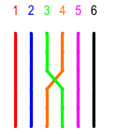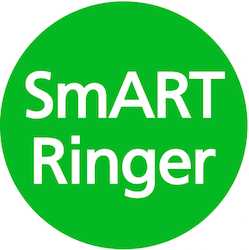Call change ringing allows you to develop the physical skills needed to move your bell within a change without needing to worry about methods. You can start to develop other ringing skills – hearing your bell in the change and correcting its position so that the change is regular [good striking] and the ability to see where other bells are in the change [ropesight].
Watch the video to find out more about Call Changes (†)
What is a Call Change?
A Call Change is when the conductor calls for two adjacent bells to swap places. For example from rounds (1 2 3 4 5 6) the conductor’s call “3 to 4” will swap the two identified bells so that the order of the bells becomes (1 2 4 3 5 6):
(1 2 3 4 5 6) becomes (1 2 4 3 5 6)
Calling up or calling down
Before you ring call changes you need to be aware that there are different ways of calling them! In the above example the method used is calling up. When calling up the two bells which are changing are identified. Some people just say “3, 4” or “3 and 4”.
Calling up – the conductor calls “3 to 4”
Calling down – the conductor calls “4 to 2”
Calling by place in the row – the conductor calls “3rd place bell follow 4th place bell”
These three different calls all lead to the same change! Namely rounds (1 2 3 4 5 6) becomes (1 2 4 3 5 6). Each tower will have a preferred way of calling Call Changes.
Which bells are affected by the call?

Call Change – “3 to 4”
The 3 holds up [rings more slowly for one blow]. Follows the 4 and rings in 4th place.
The 4 checks in [rings more quickly for one blow]. Follows the 2 and rings in 3rd place.
The 5 rings at the same speed. Follows the 3 and stays in 5th place.
How are the calls made?
- The conductor makes the call on a handstroke.
- You ring the backstroke as normal.
- If affected by the call you move your bell on the following handstroke.
- The preparation for the change in speed is made the blow before the change.
- Two bells swap places. One rings more quickly, one rings more slowly.
- The change of speed is only for one blow, rounds speed is then resumed.
Every time a call is made you should make yourself aware of your new place in the row, which bell you are following, which bell that bell is following and who is following you.
Call changes can also be made starting on a backstroke, in which case the call is also made at backstroke.
Have You Got it?
Test your understanding of call changes by taking the online quiz.
Supporting Resources
Download an aide-memoir of musical changes
Test your understanding using downloadable Call Change Quiz
Write your own Call Changes in a series of graded challenges
Call Changes Dominoes or Dominoes game to play with your ringers who are learning Call Changes
Read more about Call Changes and their role in learning to ring (*)
Learn more about calling Call Changes (*)
Find out more about keeping track of where you are in the change – what you need to know and do (*)
Acknowledgements
(*) The Learning Curve – sponsored by the Central Council Education Committee
(†) Roger Booth
